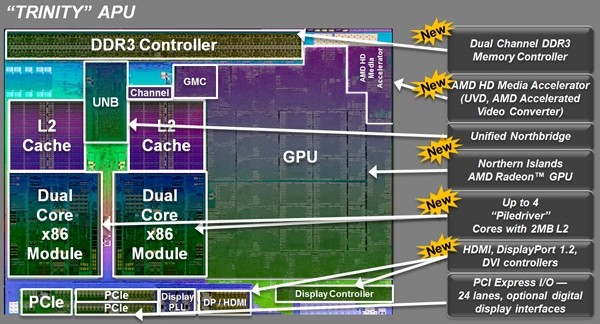AMD has launched their second generation Accelerated Processing Units (APUs) for mainstream and ultrathin notebooks, traditional and all-in-one desktops, HTPCs and embedded designs. Codenamed "Trinity", the new APUs are described as a ground-up improvement over first generation components with double the performance per watt of Llano parts.
As before AMD is not targeting the performance market and Trinity is not meant to compete direclty with Ivy Bridge for the most part. On the mobile market, Trinity should present an interesting alternative for ultrabook-style laptops where a balance of features, low power consumption, and integrated graphics are the norm.
Trinity features an AMD Piledriver CPU core that uses 3rd gen Turbo Core technology that shifts power between the CPU and GPU as needed. The technology can effectively ramp up the CPU core clock to 3.2GHz. Other key features include a dual channel DDR3 memory controller, an AMD HD Media Accelerator, a unified northbridge and up to four Piledriver CPU cores with 2MB L2 cache.
Radeon HD 7000 graphics are said to provide up to 56 percent better performance that the previous generation. Notebooks featuring Trinity APUs will boast battery life up to 12 hours through CPU and GPU power enhancements.

"Our 2nd Generation AMD A-Series APU is a major step forward in every performance and power dimension, allowing users to enjoy a stunning experience without having to give up the things that matter to them most. This experience doesn't stop at mainstream notebooks. It carries over into affordable ultrathin form factors featuring the latest in AMD Radeon graphics," said Chris Cloran, corporate vice president and general manager of AMD's client business unit.
AMD has released three different APU models for mainstream notebooks: A10-4600M, A8-4500M and A6-4400M, all featuring a 35W TDP with varying CPU core counts and clock speeds. Ultrathins will see the quad-core A10-4655M clocked at 2.0GHz and carrying a 25W TDP while the dual-core A6-4455M will include a 17W TDP at 2.1GHz. AMD notes that desktop systems and component channel parts will be available later this year.